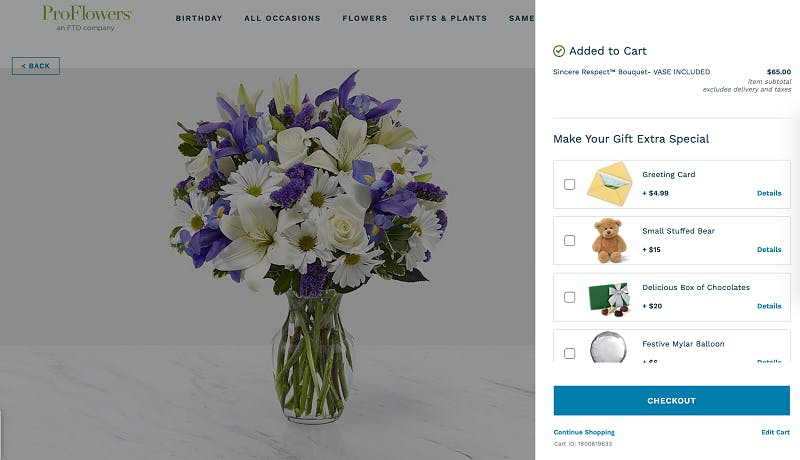Product recommendations can be a highly effective way for ecommerce websites to boost discovery, and to drive higher average order value.
According to Publicis Sapient and Salesforce, just 6% of digital shoppers in a study were found to click on product recommendations. However, these same shoppers accounted for a staggering 37% of revenue.
Not all product recommendations have to be delivered early on in the customer’s journey. The moment when a customer adds an item to their bag can also be the perfect opportunity, allowing retailers to upsell or cross-sell just before the point of checkout. This topic was recently highlighted by consultant Dan Barker in his recent thread of ecommerce tips.
72. UX.
The bag page/step is next most important. It’s the point at which – after adding something to their cart, there is an opportunity to either:
a) move directly to purchase.
b) find something else of interest.The content/ux at that stage forms part of those decisions. pic.twitter.com/yFjn1I1SFI
— dan barker (@danbarker) February 9, 2020
So, let’s take a look at how eight retailers make product recommendations in or around the shopping bag.
Amazon
When a customer adds an item to their basket on Amazon, they are then taken to a new page where they are offered multiple product recommendations, including ‘sponsored products related to…’ and ‘customers who shopped this also shopped…’.
This page flow gives the shopper a moment of pause before they make the decision to ‘proceed to checkout’. It does feel a little disruptive, but it’s a sure-fire way to confront the user with something they might have missed before they make a final purchase.

Not on the High Street
Not on the High Street uses an overlay to recommend products that the customer ‘may also like’.
The customer has the option to simply click away or onto something within the box (such as ‘continue shopping’ or ‘go to basket’ or a recommended product).

Lakeland
Lakeland does something similar on its website, suggesting products that ‘other customers have bought’.
The ‘add’ button underneath each recommended item is a nice addition, making it super quick and easy for shoppers to add further items to their basket in the spur of the moment. The low price point of each item also means there’s more chance the customer will do so.
Additionally, there’s social proof to further drive interest, with star ratings to show that items have been positively received by others.

Bose
Bose takes a different approach to product recommendations, instead placing them directly on the checkout page. Interestingly, there are none before this point (with a notable absence on any of its product pages).
As the brand’s items are typically of a higher price point, this could help to combat distraction in the browsing process, instead piquing the shopper’s interest in complementary or related items only after they’ve made a definitive decision about their main purchase.

Uniqlo
Uniqlo aids product discovery with its recommendations, telling customers: ‘you may want to try it with…’.
The recommendations are a bit disappointing in reality, as they don’t appear to be include anything that might complement the items added to the basket, and seem to be more like randomly selected items.
That being said, it’s still a nice way to get customers thinking about how they might make an outfit complete.

Currys PC World
Instead of taking customers straight to checkout, Currys PC World uses a ‘mini bag’ technique which appears at the right-hand corner of the screen, and displays items that other customers have also bought.
The design here is effective, but one negative to note is that it’s not possible to click on anything inside the box other than ‘add to basket’. Although this prevents distraction, it’s debatable whether customers will add high-price items without finding out more information or browsing the product page.

ProFlowers
ProFlowers uses the same format as Currys PC World, but in this instance it is much more effective, mainly because the items being recommended are add-ons to a gift, i.e. something to ‘make your gift extra special’.
This means that customers are more likely to increase their average order value without too much thought or consideration, particularly as the items are promoted in relation to how much extra the total price will be (such as ‘+$4.99’).

Dell
Finally, Dell positions its bag recommendations as bundle purchases, meaning that customers will get a discount on popular products if they buy them alongside what they’ve already added to their basket.
This is an effective way to upsell, with customers more likely to be tempted with the knowledge that they could be getting a bargain deal (and one that won’t be possible to find elsewhere).

Seen any great examples? Let us know.




